“I would rather entertain and hope that people learned something than educate people and hope they were entertained.” —Walt Disney
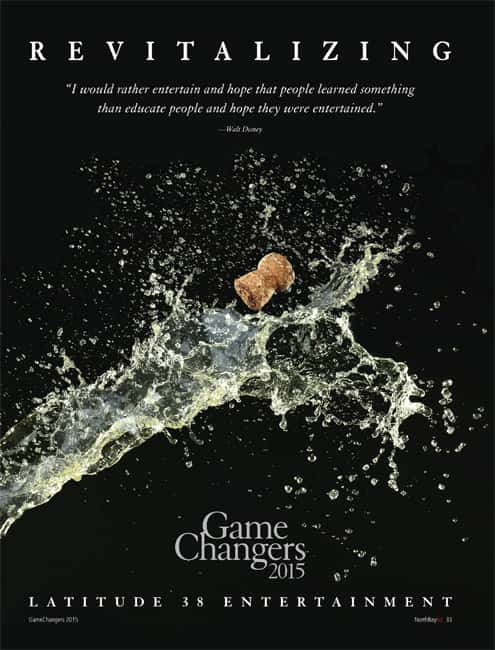 Had you been at BottleRock in 2013, you might have seen Dave Graham, Jason Scoggins and Justin Dragoo rocking out in the audience, grooving on the music, wine and food. “I had this unforgettable moment that first year as an attendee,” says Graham. “I was eating Morimoto ribs, drinking a huge Napa Cab and listening to The Black Keys. And I was thinking, ‘Is this really happening right here in my hometown?’ We were all looking forward to the next one.”
Had you been at BottleRock in 2013, you might have seen Dave Graham, Jason Scoggins and Justin Dragoo rocking out in the audience, grooving on the music, wine and food. “I had this unforgettable moment that first year as an attendee,” says Graham. “I was eating Morimoto ribs, drinking a huge Napa Cab and listening to The Black Keys. And I was thinking, ‘Is this really happening right here in my hometown?’ We were all looking forward to the next one.”But for a few touch-and-go months, it seemed like the next one wasn’t going to happen. The roadies hadn’t even begun to strike the set when payment disputes arose. There were very public accusations of financial mismanagement. Checks bounced. Bankruptcy was declared. It was more bottle shock than BottleRock.
Flash forward to BottleRock 2015: Once again Graham, Scoggins and Dragoo were in the audience—but this time they were acting (for the second time) as the festival’s promoters, as business ambassadors and, most important, as evangelists of the brand promise that propelled them to form Latitude 38 Entertainment, the production company that now runs BottleRock.
“We heard the warnings to stay away from the festival,” says Graham, Latitude 38’s president and CEO. “We came into it with a clear understanding that we didn’t really know anything about the music business. But, with the benefit of hindsight, we recognized that there were a few fundamental decisions that were made the first year that weren’t the right ones. It wasn’t rocket science: If we could just correct the mistakes, we could turn the festival around.”
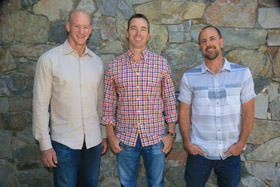 Turn it around they did. In its 18-month lifespan, Latitude 38 Entertainment—named for Napa’s geographic location along the 38th parallel north—has repaired BottleRock’s financial solvency and reputation; earned the trust and support of local businesses, civic organizations and community residents; and created a blueprint for a one-of-a-kind music, wine and food festival that will draw even more people to Napa Valley in the years ahead.
Turn it around they did. In its 18-month lifespan, Latitude 38 Entertainment—named for Napa’s geographic location along the 38th parallel north—has repaired BottleRock’s financial solvency and reputation; earned the trust and support of local businesses, civic organizations and community residents; and created a blueprint for a one-of-a-kind music, wine and food festival that will draw even more people to Napa Valley in the years ahead.Many fans say BottleRock 2015 was the best yet. The headliners—Imagine Dragons, Robert Plant and No Doubt—played stellar sets of crowd-pleasing rock ‘n roll that spanned generations, while more than 60 other acts across four stages offered plenty of alternatives, from Snoop Dogg, the Gipsy Kings and Los Lobos to Public Enemy, Michael Franti and local surf rockers the Deadlies. Food, wine and beer booths were expanded. There were also a number of Napa Valley wineries pouring, including the festival’s title sponsor, Miner Family Winery, along with Silver Oak Cellars, Robert Mondavi and Clos du Val.
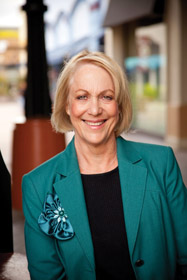 “I heard super positive things about Latitude 38’s leaders during the festival,” says Napa Mayor Jill Techel. “They’re really trying to help the local businesses, and they’re involved in the event at every level. They want to be sure it has plenty of ‘Wow!’ experiences for everybody.”
“I heard super positive things about Latitude 38’s leaders during the festival,” says Napa Mayor Jill Techel. “They’re really trying to help the local businesses, and they’re involved in the event at every level. They want to be sure it has plenty of ‘Wow!’ experiences for everybody.”Each of the partners plays a different role in the company: Graham oversees artist relations, booking bands, marketing and PR; Scoggins manages sponsorships and partnerships; and Dragoo serves as CFO and oversees festival production. But they all participate in one form or another in virtually every area of the business. “It’s very much a partnership and everyone has an equal vote,” Graham says. “But as CEO, I can make the final call if we can’t agree on big decisions that need to be made.”
“There’s cohesion in the leadership direction at Latitude 38 that seems to resonate with everyone involved with BottleRock,” says Travis Stanley, president and CEO of Napa Chamber of Commerce. “That’s very important when you have the type of aspirations they have for the event. Their staff, vendors and sponsors—even the musicians—really seem to want to play their respective roles in helping create the ‘new’ BottleRock and make it the best music, culinary, art and wine festival in the world.”
Just another startup
The company founders are all from the area and have been hanging out together since junior high; Graham and Scoggins have actually known each other since elementary school. And while they moved in separate directions during college and early adulthood—Graham and Scoggins ventured into tech startups in Silicon Valley, Dragoo played pro football (mostly for the Denver Broncos and Carolina Panthers) and ran a global IT business for IBM—they kept in close touch and, eventually, all returned to Napa.
In one sense, BottleRock was just another startup for Latitude 38. “That’s how we treated it,” Graham says. “The scary part of starting a business is you never really know what people are going to buy. With BottleRock, we had the luxury of seeing that there was a demand for a product that involved wine and food from the Napa Valley along with music; and if you have the demand, you need to answer the questions: ‘Is it sustainable?’ and ‘Can you differentiate yourself from others?’
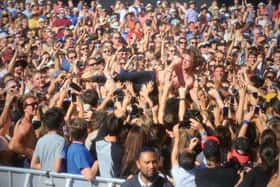 “We knew there was an amazing festival in San Francisco called Outside Lands, and another one in Southern California at Coachella. But we also knew that there are 3 million people who come to Napa Valley every year for wine, food and weather—and that was our differentiator. Could we attach our company and BottleRock to the brand promise that comes with Napa Valley? That’s what we’ve strived to reach in terms of the experience we want to create.”
“We knew there was an amazing festival in San Francisco called Outside Lands, and another one in Southern California at Coachella. But we also knew that there are 3 million people who come to Napa Valley every year for wine, food and weather—and that was our differentiator. Could we attach our company and BottleRock to the brand promise that comes with Napa Valley? That’s what we’ve strived to reach in terms of the experience we want to create.”As they began crunching the numbers, they realized their potential audience was older, wealthier and more sophisticated—and not necessarily inclined to attend a rock festival. But because of the nature of the Napa Valley Expo, which let patrons easily walk to multiple stages, and the lure of Wine Country with its epicurean attractions, Graham and team saw a niche waiting to be filled, one that would appeal to urban hipsters, baby boomers carrying a candle for classic rock, families and foodies. It was just a matter of applying the best practices they’d learned in their previous businesses to what was left of BottleRock.
The revitalization of BottleRock
There was much jockeying for position with major festival producers like Live Nation and AEG in the wake of the first-year debacle. Most production companies took a sniff of the bottom line and back-tracked as fast as they could. That’s when—in an act of hubris and, perhaps, lunacy—Graham, Scoggins and Dragoo, all of whom had proved themselves to be successful businessmen, approached the Napa Valley Expo with their own pitch to promote BottleRock.
It was October 2013, seven months before the next festival was scheduled to take place. “The A-ha! moment to form Latitude 38 was when the Expo board unanimously voted to enter into contract negotiations with us to rent the Expo as the new promoters of BottleRock,” Scoggins says. “It became real at that point. Had they voted ‘no,’ there would have been no need to form a company.”
Latitude 38 bought the BottleRock brand, the database of ticket buyers and the physical assets (T-shirts, water bottles). “A lot of people didn’t understand BottleRock wasn’t a company—it was a brand,” Graham points out. They closed the purchase in January 2014, booked the final band for the 2014 lineup on March 12, and put tickets on sale for the second BottleRock festival two days later.
“Professionally speaking, 2014 was the hardest thing we ever did,” Graham says. “It was brutal trying to book the lineup.” Most touring bands were already scheduled by the time Latitude 38 contacted them; agents wouldn’t return their calls, assuming it was the same production team from the first year.
The situation was so dire that, in March 2014, the partners flew to Los Angeles to meet with the head of one of the largest music agencies in the business. “We had to convince him that we were new promoters—not the previous ones—since we were using the same brand,” Graham says. “We had to show him we were trustworthy, competent, well-capitalized and that we had skin in the game because we were investors in our own company. We told him we were working on a plan to eliminate some of the previous promoter’s debt, and that we could afford to pay 100 percent of band fees up front. Finally, regardless of the financial outcome of the 2014 festival, we pledged that all bands and vendors would be paid in full.
“By the end of the meeting, we found ourselves booking 20-plus bands with one of his agents. In retrospect, that meeting was likely a make-or-break moment for our company. Without being able to book those bands, our 2014 lineup would have been horrible, and we would have sold very few tickets to the festival.”
The company made three critical promises to the Napa community that helped lay the groundwork for the festival’s recovery. It guaranteed to host the event in 2014, to represent and reflect the unique character of Napa Valley and to eliminate a meaningful amount of the lingering debt from the previous year.
“We lost a bit of money,” Graham admits, but Latitude 38 restored nearly everyone’s faith in BottleRock. Even more impressively, the company reduced about $5 million of the previous owner’s debt, more than half of what was owed when the festival filed for bankruptcy in late 2013. “Even though we didn’t owe anybody any money, we said we’d do all we could to eliminate the debt. We paid off the Expo, which was $310,000; we wrote checks to the union, to the city, to all the different people who were owed money. That was meaningful to the bankruptcy estate, which has been very aggressive in helping to pay back creditors. We’re proud to have done our part in making a bad situation better.”
Rebuilding credibility face-to-face
BottleRock 2014 was a certifiable success in at least one monumental way: Everybody got paid. It wasn’t the festival that Graham, Scoggins and Dragoo envisioned—there simply wasn’t time to execute their master plan—but it drew more than 80,000 music, wine and food fans to Napa. Crowd and traffic control flowed better, sound abatement improved and navigating the festival itself felt easier. In keeping its word with the city of Napa, Latitude 38 even pulled the plug on The Cure and Heart when their sets ran past the 10 p.m. cut-off that had been agreed to.
“Getting the first year off without a major hitch gave us confidence,” Graham says. “We put together a really good show, and we had a good team and a good plan. But what really made us happy is that we were able to define BottleRock as representative of Napa Valley. We gave it an identify that reflected Wine Country.”
Shifting sights to 2015, the company started fresh. It redid the look and feel of the festival, and augmented messaging around the brand promise it hoped to deliver. It began a 360 review, a best business practice designed to get input from every key stakeholder in the event. “We don’t have a big production or marketing team, so we had to rebuild the credibility within the community, face-to-face. Eventually, people started to take our phone calls and invite us to meetings.”
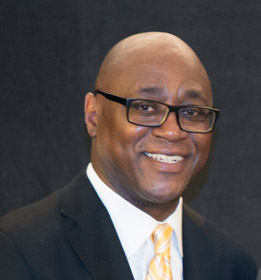
Local businesses, rebounding from the hangover of 2013, noticed the difference. Stanley at Napa Chamber credits Latitude 38’s “amazing attention to detail. I’m most impressed by their desire to create the best possible experience for everyone visiting Napa Valley during the weekend of BottleRock, whether attending the festival or not. Transportation and parking, attendee ingress and egress, neighborhood noise—virtually no stone is left unturned. Their thoughtfulness stems from the fact that they’re very passionate and considerate when it comes to the place they call home.”
Stepping it up in 2015
With the luxury of a year to plan and the lessons learned from 2014 firmly in mind, Latitude 38 produced a version of BottleRock in 2015 that was much closer to the intended vision. More than 100,000 people attended the three-day event; it wasn’t exactly peace, love and harmony by Woodstock standards, but the buzz—whether from the good vibes circulating through the Expo or from the world class wine and beer being poured—was enough to make most repeat festival-goers forget about the past.
“We stepped it up in just about every area, including the lineup, our winery and restaurant partners, and our new culinary stage,” Dragoo says. “We also wanted to step it up on the front end. Our neighborhood ambassador program increased to 70 neighbors who helped festival goers navigate their way and assisted the venue’s neighbors to protect their property from loitering or illegal parking. We also held a public meeting to tell people living nearby about our plans for the festival and answer any questions they had.”
The year’s festival also featured a new “Sky Deck”—an elevated area for VIPs that offered spectacular views of the main stage along with private food and bar service. You could nosh on Ca’ Momi Napa Valley cream puffs, crab fries from Gourmet Faire, sticky ribs from Morimoto Napa or salted pretzels from Napa Palisades Saloon. “We’ve participated in BottleRock all three years and were thrilled to be asked to participate again—and to have a bigger stake as a sponsor,” says Dario De Conti, pizzaiolo and winemaker at Ca’ Momi. “It’s exciting to see how many excellent Napa Valley restaurants, chefs and wineries were involved in the festivities.”
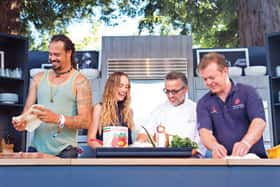 Only at a rock festival in Napa would the backstage catering menu feature Oenotri housemade chorizo breakfast burritos with taramasso farm eggs and Rancho Gordo beans, or Zuzu seafood paella with Spanish-seasoned Bomba rice cooked over an open fire with fresh local fish. “We wanted the artists, their agents and families to also experience that brand promise of Napa Valley,” Graham says. “So besides hiring arguably two of the best restaurants in Napa to handle the backstage catering, we also had massage on site, shaded picnic tables and a private, well-stocked and decorated tent for every artist.”
Only at a rock festival in Napa would the backstage catering menu feature Oenotri housemade chorizo breakfast burritos with taramasso farm eggs and Rancho Gordo beans, or Zuzu seafood paella with Spanish-seasoned Bomba rice cooked over an open fire with fresh local fish. “We wanted the artists, their agents and families to also experience that brand promise of Napa Valley,” Graham says. “So besides hiring arguably two of the best restaurants in Napa to handle the backstage catering, we also had massage on site, shaded picnic tables and a private, well-stocked and decorated tent for every artist.”Improvements were also made to transportation and parking, including the addition of an 8,000-space parking lot and free bus rides for ticket-holders—extra touches that enhance the customer experience and endear Latitude 38 to local civic organizations like the fire and police departments. “Latitude 38 has been great to work with,” says Capt. Jennifer Gonzales of the Napa Police Department. “It made some real improvements to the festival this year, like getting people to park closer to the venue and working with a local bus company to provide transportation. It’s always very quick to respond to citizen or community concerns.”
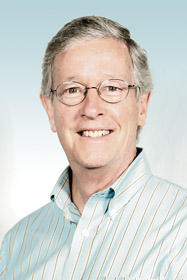 Latitude 38’s most telling success to-date has been its ability to triangulate itself into the intersection of business, government and tourism. It’s a tricky balance, says Craig Smith, executive director of the Napa Downtown Association. “Merchants were concerned that business would be way down during the event. Locals are worried that downtown would be overrun by festival attendees. Business, at least for retailers, was slow the first year. Latitude 38 made sure that, through its website and social media presence, businesses got some love. It’s worked out well.”
Latitude 38’s most telling success to-date has been its ability to triangulate itself into the intersection of business, government and tourism. It’s a tricky balance, says Craig Smith, executive director of the Napa Downtown Association. “Merchants were concerned that business would be way down during the event. Locals are worried that downtown would be overrun by festival attendees. Business, at least for retailers, was slow the first year. Latitude 38 made sure that, through its website and social media presence, businesses got some love. It’s worked out well.”Just a few days after BottleRock 2015 ended, Graham took a deep breath and declared that all the festival’s bills will be paid on time and that the event itself will generate a profit. “The difference between 2014 and 2015 was that we were able to rebrand the festival, we were able to book the lineup we wanted and to hire the right team,” Graham says. “We had time to do the little things we couldn’t get to last year. Now we’re on the map as a world-class festival, and we’ve already made many of our 2016 band offers.”
When asked what’s next for Latitude 38, Graham just smiles. “Right now, there are a lot of shiny, dangling objects being put before us. We have to stay away from them unless they’re core to our business. Once we have our 2016 game plan set, we’ll look at all the opportunities coming our way, and then we’ll decide what makes sense for the company.”
Rock ‘n’ Recipe on the Culinary Stage
 Only at BottleRock would the crowds be as large and boisterous for a cooking demonstration as a guitar solo. In a stroke of inspired genius, Latitude 38 partnered with Williams-Sonoma to create a fifth stage at the festival on which musicians, athletes and other celebrities teamed up with famous chefs to create gourmet dishes on the spot.
Only at BottleRock would the crowds be as large and boisterous for a cooking demonstration as a guitar solo. In a stroke of inspired genius, Latitude 38 partnered with Williams-Sonoma to create a fifth stage at the festival on which musicians, athletes and other celebrities teamed up with famous chefs to create gourmet dishes on the spot.“BottleRock is all about blending great music, food and wine,” Dave Graham says. “For 2015, we wanted to ramp up our culinary experience with the help of Williams-Sonoma. The idea was to mash up celebrity chefs with artists, actors and athletes to create some entertaining and irreverent content.” The result: Snoop Dogg rolling sushi with Iron Chef Masaharu Morimoto, Flavor Flav (of Public Enemy fame) teaming up with Chef Michael Voltaggio to cook chicken and waffles, and Michael Franti and Zella Day taking the stage with Dario De Conti, co-owner of Ca’ Momi and New York Chef Roberto Caporuscio to make pizza.
There were other memorable “mash-up” moments from musicians Scott Weiland, former front man for Stone Temple Pilots; Ben McKee of Imagine Dragons; No Doubt’s Adrian Young; pro football players Charles Woodson (of the Oakland Raiders) and Vernon Davis (of the San Francisco 49ers); and ’60s activist Wavy Gravy.
“We were excited to create unique culinary experiences for festival attendees that differentiated BottleRock from all other food and music festivals,” says Janet Hayes, president of Williams-Sonoma.
10 Inglorious Truths About Booking Bands for a Rock Festival
 (As learned by the guys at Latitude 38 after a bunch of frustrating experiences trying to break into the promoter business)
(As learned by the guys at Latitude 38 after a bunch of frustrating experiences trying to break into the promoter business)1. No matter how much money you have to spend on bands, you can’t always book the band you want.
2. Popular bands have a lot of leverage in the negotiation.
3. It takes a long time to book a popular band—like, almost-a-year long, in some instances.
4. If your festival business model is based on booking a great lineup every year, your business will fail.
5. A “no” is just as important as a “yes,” because it lets you move on to search for another band instead of being paralyzed hoping for something to happen.
6. Counter programming is key in terms of selling tickets and providing a great experience at the festival; for example, good counter programming would schedule Robert Plant to play against Passion Pit and Lettuce—three different genres of music playing against one another at the same time.
7. If you get a “yes” from a headliner, you should take it. There are very few true headliners touring at any one time, so take them while you can get them.
8. If you end up overpaying the headliner because there aren’t many headliners available, you gain immediate admission to the Long-time Promoter Club. (Every long-time promoter has overpaid for a headliner at one time or another.)
9. Don’t book bands you like. Book bands that meet the demands of your customers.
10. There’s both an art and science to booking bands—and both are equally necessary when booking a lineup.
Talking Trash
Amid the music, art, wine, craft beer and culinary delights at BottleRock Napa Valley 2015, something was missing: trash.
This year, Latitude 38 Entertainment, producers of the three-day festival, along with Napa Valley Expo, home of BottleRock Napa Valley, teamed up to reduce waste and significantly increase the amount of material to be recycled and composted.
“We’re glad to have partnered with ZeroHero, Napa Valley Expo, Sustainable Napa County, Napa Recycling & Waste Services and Best Beverage Catering. It was a collaborative effort to keep the venue, surrounding neighborhoods and downtown clean and reduce the waste that would end up in our landfill,” says Jason Scoggins, Latitude 38 Entertainment co-founder and partner. “We feel good about the results of this first year partnership and we hope to do even better next year and beyond.”
The efforts paid off. Over the course of the three-day festival, nearly 50 tons of recycling was hauled away by Napa Recycling and Waste Services (NRWS). In addition, close to 4 tons of food waste will be composted by NRWS and returned to yards and gardens throughout Napa Valley.
Key to the success of this year’s effort was the creation of a BottleRock sustainability team made up of local stakeholders including NRWS and Sustainable Napa County. In addition, the Napa Valley Expo contracted with ZeroHero to manage trash, compost and recycling programs throughout the grounds and to provide the green team to help attendees dispose of items in the right receptacles in both public spaces and behind the scenes. The impressive diversion numbers also included waste management from the several event parking lots and the city streets and neighborhoods surrounding the 26-acre Expo grounds.
The BottleRock sustainability team also made it a priority to communicate diversion goals with food and beverage vendors and with attendees, a key component to the success of the effort. Says Jeri Gill, CEO of Sustainable Napa County, “Making vendors and guests feel like partners in the effort to reduce, reuse and recycle was key to this effort. Sharing the responsibility—and the success—is what made this program work so well.”



